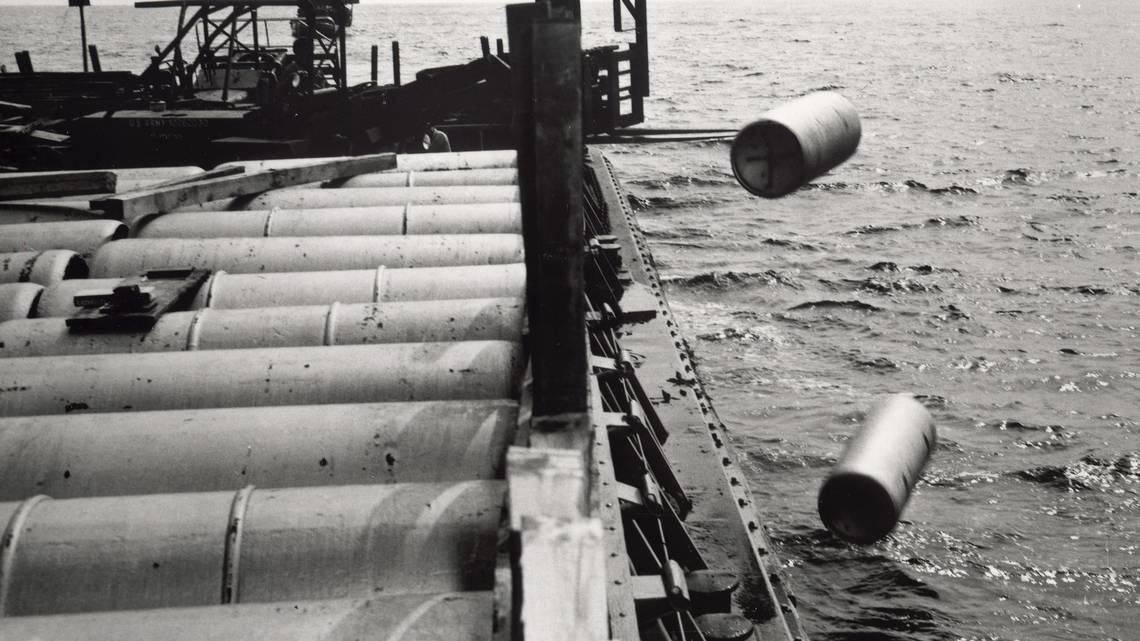The State
June 10, 2018
BY TONY PUGH, McClatchy
WASHINGTON
In a long-shot bid to stop seismic testing for oil and gas in the Atlantic Ocean, coastal business leaders and elected officials are raising concerns the tests could cause toxins to leak from vast amounts of conventional munitions, chemical weapons and radioactive waste that now sits undisturbed on the ocean floor.

For decades, the U.S. military routinely dumped thousands of tons of obsolete, excess and captured munitions into U.S. coastal waters, thinking the high seas were the best place for the materials to safely decompose. The Atomic Energy Commission likewise oversaw the ocean dumping of untold thousands of drums of low-level radioactive waste from the nation’s manufacturing, research, medical and military sectors.
As President Donald Trump pushes to make more offshore waters available for oil and gas drilling, the administration wants to make it easier for companies to use seismic testing to aid in the exploration process. But coastal leaders say allowing seismic testing in the Atlantic Ocean could disturb the long-forgotten hazardous refuse and release toxic contaminants.
“Over the last couple years, people have asked me why I have been so opposed to seismic surveys off our coast,” Mayor Billy Keyserling of Beaufort, South Carolina, said in a recent statement. “But when I now tell them about the radioactive waste and munition dumps, they are horrified and ask what they can do to help.”
Keyersling and others want to block the seismic testing plan, but their lobbying campaign may be coming too late to affect the Trump administration’s upcoming decision on whether to move the seismic permitting process forward.
PRELUDE TO DRILLING
Five companies want federal approval to shoot pressurized air blasts into the ocean every 10 to 12 seconds around-the-clock for months at a time in search of fossil fuel deposits beneath the ocean. The proposed seismic testing area would cover over 330,000 square miles of ocean from Florida to the Delaware bay.
In public comments to the National Oceanic and Atmospheric Administration, businesses and residents along the eastern seaboard strongly opposed seismic testing, fearing it could lead to offshore drilling which, they fear, could harm marine life, tourism and commercial and recreational fishing.
The public comment period ended in July 2017. But because of the large volume of comments, NOAA Fisheries hasn’t yet decided whether to issue or deny the testing companies’ request for “incidental harassment authorizations” that allow small numbers of marine mammals to be injured or disturbed in testing operations.
SARIN AT SEA
The delay has allowed testing opponents to mount a new attack, claiming that shock waves from the underwater air blasts could detonate or cause toxic chemicals to leak from tons of U.S. bombs, grenades, rockets and mortars that the U.S. military dumped in the Atlantic Ocean from the end of World War I until 1970.
Chemical warfare agents were also discarded in the Atlantic, including 10,000 tons of lewisite, an arsenic-laced blister agent; nearly 6,000 tons of mustard; more than 500 tons of arsenic trichloride and more than 250 tons of sarin, according to a 2009 report by the Department of Defense.
In all, 33 munitions disposal sites are scattered along the Atlantic Coast from Florida to Maine, encompassing much of the ocean area where the proposed testing would occur, the DOD reported.
NJ NUCLEAR DUMPS
Similar concerns have been raised about the air blasts causing leaks in rusting, steel drums of radioactive waste that were dumped in the Atlantic Ocean under the guidance of the old Atomic Energy Commission.
From 1946 through 1962, the U.S dumped “approximately 89,400 containers with an estimated inventory of 94,400 curies of radioactivity” in the Atlantic and Pacific Oceans, according to a 1980 Environmental Protection Agency report prepared for a House subcommittee.
Ninety-six percent of “all radioactivity dumped in the Atlantic” was discarded in sites off the coast of New Jersey, the report said.
One dump site located 140 miles southeast of Coast Guard Station Sandy Hook in Highlands, N.J., received 14,301 containers totaling 74,400 curies of radioactivity from 1951 to 1956 and from 1959 to 1962. Another site, 220 miles southeast of the Sandy Hook station, received 14,500 containers with 2,100 curies of radioactivity from 1957 to 1959, the EPA report said.
The containers typically stored low-level radioactive waste, such as contaminated equipment, tools and clothing, which were usually encased in concrete-filled steel drums, the report said.
Even though both New Jersey dump sites are outside the area where the proposed seismic testing would occur, other Atlantic Ocean dump sites not included in the EPA report have also received radioactive waste, said seismic testing opponent Frank Knapp, president and CEO of the South Carolina Small Business Chamber of Commerce.
RUSTY STEEL DRUMS
James W. Porter, an ecology professor emeritus at the University of Georgia, said he doubts that seismic testing could detonate long-discarded explosives. But months of constant air blasts might dislodge or disturb the weapons’ rusting, deteriorating casements, Porter said.
That could send toxic contents into the ocean, endangering marine life and human life through long-term exposure. Porter said the same is true of the rusting steel drums filled with radioactive waste.
Ken Milito, director of Upstream and Industry Operations for the American Petroleum Institute, said the concerns are bogus.
“There is absolutely no evidence that seismic testing has or would have any impact on any kind of munitions,” Milito said. “We’ve never seen that or heard of that. We think it’s just another fear-mongering attempt to try to create and stir doubts about our ability to do (the tests) safely,” he said.
http://www.mcclatchydc.com/news/nation-world/article212742559.html

